
ISSN: 2321 9653; IC Value: 45.98; SJ Impact Factor: 7.538

Volume 10 Issue XI Nov 2022 Available at www.ijraset.com


ISSN: 2321 9653; IC Value: 45.98; SJ Impact Factor: 7.538

Volume 10 Issue XI Nov 2022 Available at www.ijraset.com
Deepal V1 , Rachith K2
1PG Student, Construction Technology, Nagarjuna College of Engineering & Technology, Bengaluru, Karnataka, India
2Assistant Professor, Department of Civil Engineering, Nagarjuna College of Engineering & Technology, Bengaluru, Karnataka, India

Abstract: The effect of using basalt fibers on the fresh, mechanical and durability properties of concrete was investigated in this study. The study was performed using different basalt fiber volume fractions of 0.5%, 0.7%, 1%, and 1.5 %, with water/cement (w/c) ratios and 0.40 is utilized. The results were compared to conventional concrete with various percentage of basalt fibers volume fractions. The testing for fresh properties included slump and unit weight tests; mechanical properties testing included compressive strength tests, split tensile strength tests, and flexural strength tests, durability testing included rapid chloride penetration test, water permeability, water absorption, SEM and EDS and XRD tests. The test results showed that the use of basalt fibers reduces slump values as the fiber volume fraction increases; however, with the use of the appropriate amount of High Range Water Admixture (HRWA), target slump values can be achieved. Moreover, a considerable improvement in the compressive, tensile, flexural, average residual strength and durability properties was achieved in case of using basalt fibers. On the other hand, corrosion rates increased with the increase in fiber volumes. However, it can be concluded that utilizing a 0.70% fibers volume fraction is the optimum ratio with an overall acceptable performance with respect to mechanical and corrosion properties.
Keywords: High Performance Concrete, Basalt Rock Fiber, Mechanical and Durability Properties.
Concrete is among the most fundamental and important building material as in 21st century, and has been used to construct a variety of high rise structures, dams and other infrastructures. Concrete which gives strength and also it is durable. Cement, water, fine aggregate and coarse aggregate together make up concrete, which is a heterogeneous composition. The production of concrete has been reached approximately 4.4 billion tones around the world. As the demand of the concrete increase in the construction field gradually the demand of cement and other natural resource also increases. So, this results in a huge production of Portland cement in the manufacturing industries which releases huge amount of co2 to the atmosphere which leads to global warming and climate changes. Approximately 1 ton of co2 is discharged into the environment for every 1 ton production of ordinary Portland cement. Study shown that around 7% of co2 is emitted from cement manufacturing process around worldwide. In the construction field concrete have a great opportunity to replace the cement with alternative materials which is resulting from industrial waste such as silica fumes, GGBS, rice husk ash, coal ash etc. in order to control the environmental pollution. In terms of mechanical qualities and durability, high performance concrete (HPC) is superior than regular strength concrete. Reducing the amount of concrete in a structure has advantages, including reducing the need for concrete forms, erection labour, and construction time. Given the benefits that have been established, it is surprising that HPC is not used widely. This is because concrete costs a lot of money and has a big environmental impact per cubic metre. As a result, tremendous care has been taken to develop HPC with lower costs and lower emissions while offering the same features. Contrarily, fibres are frequently utilised in reinforced concrete, namely fibre reinforced concrete, to reduce cracking and lower the permeability of the material. Concrete can be reinforced with a variety of fibre kinds, including glass, steel, synthetic, and natural fibres. Every fibre type has benefits and disadvantages. The basalt fibre is a novel type of material that performs admirably and is "more environmentally friendly," making it a suitable substitute for conventional fibres as a reinforcing component in concrete.
From literature study it is found that addition of fibers to the concrete gives adequate strength controls the failures due to alkali silica reaction in concrete and prevents corrosion to some extent. There by enhances the durability. All the literature study gives the idea regarding the utilisation of basalt fiber to get the Properties by using different ratios.
ISSN: 2321 9653; IC Value: 45.98; SJ Impact Factor: 7.538 Volume 10 Issue XI Nov 2022 Available at www.ijraset.com
To find the strength and durability of concrete using GGBS, silica fume in addition with basalt fibre is the main concept of this Report and many tests are conducted to find out. Compressive strength test, Flexure strength test, Split Tensile strength and durability test are conducted to know its Strength and aging period. Microstructural analysis is carried to study the components of the materials used. Then we can easily compare the results with any other related topics.

Concrete: Coarse aggregate (20mm & 12.5mm) passing, fine aggregates, Birla super cement OPC (ordinary Portland cement) 53 grade, GGBS, Silica fume, super plasticizer and water.
For current experimental exploration thorough examination of materials have been carried out & noted below.
1) Cement & Cementitious material
Birla super cement of OPC 53 grade validating to IS: 12269 1987 is adopted. As indicated to terms of IS: 4031 1968, firm tests were executed in command to gain the properties of cement OPC 53 grade.
Table 1 OPC 53 Grade Cement Physical Properties used for Experimentation Table 2 OPC 53 Grade Cement Chemical Properties used for Experimentation
Sl. No. Specifics
Results attained OPC 53 Grade 1 Standard uniformity {%} 29% 2
Compressive strength, MPa 72+/ 1hr 168+/ 2hr 672+/ 4hr
Necessities as per IS 12269 2013
Sl. No. Specifics
Necessities as per IS 12269 2013
Not<27 Not<37 Not<53
38.6 49.8 65.8 3 Setting time (minutes) Early final
Results of OPC 53 Grade 1
Rati0 of Lime % to % of Silica, Alumina and Iron 0xide, when worked out by down given expression CaO 0.7SO3
Minimum 0.80 Maximum 1.02.
Minimum 30 min Maximum 600 min

Maximum 10 mm 0.6 mm
215 minutes 300 minutes 4 Finess, Kg/m2 Minimum 225 285 5 Specific gravity 3.15 6 S0undness, millimeters (Le chatelier’s expansion)
0.9 2.8SiO2+1.2Al2O3+0.65Fe2O3 2 Sulphuric Anhydride% by mass Maximum 3.50. 2.52 3 Chlorides % by mass Maximum 0.10 0.001 4 Magnesia % by mass Maximum 6.0. 1.11 5 Al2/Fe03 Minimum 0.66 1.36
ISSN: 2321 9653; IC Value: 45.98; SJ Impact Factor: 7.538 Volume 10 Issue XI Nov 2022 Available at www.ijraset.com

By quenching molten iron slag from a blast furnace in water or steam, which results in a glassy, granular product that is subsequently dried and ground into a fine powder, one can create ground granulated blast furnace slag (GGBS or GGBFS). GGBS is delivered from the QUALITY POLYTECH dealer on JC Road for building supplies. (Table 3)
Table 3 Physical properties of GGBS Table 4 Physical properties of Silica Fume
Physical properties GGBS
Colour Off White
Specific gravity 2.9 Consistency 34% % particles retained on 90μssieve Nil
Physical properties Silica Fume Colour Off White Specific gravity 2.83 Consistency 34% % particles retained on 90μssieve Nil
Silica fume, a by product of the ferrosilicon industry, is a highly pozzolanic material that is used to enhance mechanical and durability properties of concrete. It may be added direct to concrete as an individual ingredient or in a blend of Portland cement and silica fume. (Table 4)
Coarse aggregate of 20mm down size were taken. The properties of coarse aggregates namely loose bulk density, el0ngation index, specific gravity, flakiness index. Sieve analysis of the samples i.e., 20mm & 12.5mm are carried out greatest dimensioned coarse aggregates as indicated IS: 2386 (Part I) 1963. (Table 5)
Table 5 Physical Properties of CA Table 6 Physical properties of Fine aggregate SI NO Specifics Results obtained SI NO Specifics Test Results 1 Water absorption 0.31% 1 Specific Gravity 2.59 2 Specific gravity 2.63 2 Fineness modulus 5.16 3 Elongation index % 10.0 3 Zone I 4 Flakiness index% 9.6 4 Bulk density g/cc 1685
The fine aggregate used was M sand obtained from local source. The specific gravity of sand was 2.54 and fineness modulus of the sand wasS5.16. As per IS 383 1976, the particle size distribution of sand shows that it is .in zone II (Table 6)
The material known as basalt fibre is created from the incredibly fine basalt fibres, which are made up of the mineral plagioclase, pyroxene, and olivine. Although it is substantially less expensive than carbon fibre, it is comparable to fibreglass and has better physicomechanical qualities than fibreglass. The aerospace and automotive industries utilise it as a fireproof cloth, and it may also be used as a composite to make items like tripods for cameras. We are employing fibres from chopped basalt for our purpose.
The superplasticizer used for the work is CFLOW 154 M1

ISSN: 2321 9653; IC Value: 45.98; SJ Impact Factor: 7.538

Volume 10 Issue XI Nov 2022 Available at www.ijraset.com
Water which is clean and uncontaminated available in laboratory gratifying the requisite as per IS 4562000 is utilised for concrete in this work.
The mix design was prepared using data obtained from the preliminary investigation. Based on the Indian Standards Recommended Guidelines IS: 10262 2009 the concrete mix has been designed. M 30 mix was considered for the conventional mix design under mild condition with using any chemical admixture and water cement ratio 0.4 is considered in this investigation. Here basalt fibres are used in 0%, 0.5%,0.7%, 1%, and 1.5%. The Mix Proportion is carried out in the further steps.
1) M40 Grade Concrete Specimen Computation
2) Mix Design Parameters for M30 using basalt fibers
3) Designation of Grade = M30

4) Form of Cement = OPC 53 Grade
5) Minimum Cement Content = 370kg/m3
6) Adopted content of cement = 410kg/m3
7) Super plasticizer = CFLOW 154 M1
8) Slump value = 75mm
Specific Gravity
Cement = 3.15
Fine Aggregate = 2.59
Coarse aggregates (20mm & 12.5mm) = 2.63 Water Absorption
Coarse Aggregates = 0.31%
Fine aggregate = 4.5%
Exposure taken into account = Extreme Placing Method = Dumping Workability = 75 mm mm
Maximum W/C ratio = 0.40 as designated in IS 456 2000 Adopted W/C ratio 0.40
Mix Proportions For Trial Number 1
Cement = 270 kg/m3 GGBS = 74 kg/m3
Silica fumes = 25.9 kg/m3 Water (Net mixing) = 148 kg/m3
Fine aggregate (SSD) = 772 kg/m3 Coarse aggregate (SSD) = 1205 kg/m3
Chemical admixture = 3.7 kg/m3
The following steps involved in preparing and testing of specimen are:
1) Mixing of concrete
2) Test on Fresh concrete and hardened concrete
3) Durability test on concrete
A. Mixing Of Concrete
Concrete grade of M 30 is designed in replacing cement with GGBS and silica fume in percentage with 7% and 20 % and with various percent of basalt fibers. Here weight batching method was used in this investigation. Individual batch quantity was calculated in order to cast cubes, cylinder and beam. Here drum mixer was used for concrete mixing.
ISSN: 2321 9653; IC Value: 45.98; SJ Impact Factor: 7.538

Volume 10 Issue XI Nov 2022 Available at www.ijraset.com
Testing on fresh concrete was conducted to evaluate the workability of concrete. Here slump test is conducted; the goal of slump check is to measure concrete’s workability. Slump cone test: The cone utilised here is having a dimension of 300mm in length, 100mm internal diameter at top and 200mm diameter at the bottom of the cone. The nonporous base plate holds the cone.
To carry out the experimental investigation cubical mould of size 150×150×150mm, cylindrical mould of size 300mm length and 150mm internal diameter and beam size 100×100×500mm were casted for evaluation of compression strength, split tensile strength and flexural strength test.

Curing is one of the important steps. In this investigation water curing is carried out in order to prevent water loss in concrete specimen. Firstly, the casted specimen are kept 24 hours in the normal temperature and then the specimen are de moulded after de moulding the samples are placed inside the curing tank under fully submerged condition for various curing period such that 7 and 28 days.
For controlling and ensuring a high standard of cement concrete activities, hardened concrete test is essential. Hardened concrete testing carried to verify that the concrete used on the project site has reached the requisite strength. All of the examinations were completed in accordance with IS specifications.
The various test conducted under this investigation are:
1) Compression Strength Test 2) Split Tensile Strength Test 3) Flexural Strength Test 4) Water Permeability Test 5) Rapid Chloride Penetration Test 6) Sorptivity Test 7) Water Absorption Test 8) Scanning Electron Microscopy Test 9) Energy Dispersive Spectroscopy Test 10) X Ray Diffractometer Test
The Compressive strength of HPC for various percentage of basalt fibre for a curing period of 7 and 28 days was determined and the results are tabulated and the comparison of different combination was shown.
Table 7. Compressive strength of HPC with various percentage of basalt fibre
SI NO Samples
Compressive strength insN/mm2 for different Curing Periods in days
7 Days 28 Days
1 0% BFC 22.22 35.48 2 0.5% BFC 19.99 36.15 3 0.7% BFC 23.75 41.1 4 0.9% BFC 19.5 34.9 5 1% BFC 15.63 32 6 1.5% BFC 14.52 31.9
ISSN: 2321 9653; IC Value: 45.98; SJ Impact Factor: 7.538


Volume 10 Issue XI Nov 2022 Available at www.ijraset.com
40
30
20
10
0
50 0% 0.50% 0.70% 0.90% 1% 1.50% % OF BASALT FIBRE
1) During compression testing the cracks were found near the edges due to less reaction near the edges.
2) The cracks were vertical for all the various percentage of basalt fibers.
3) When compared with the test results addition 0.7% of basalt fibers to concrete gives adequate strength when compared to normal concrete and also other percentage replacement of basalt fibers.
4) When compared with 0% of basalt fiber in concrete and 0.7% of BFC , the compressive strength obtained for 0.7% is 41.1 N/mm2, 15.83% of strength is increased with 0.7% of BFC when compared to 0% BFC.
The split tensile strength of HPC for various percentage of basalt fibre for a curing period of 7 and 28 days was determined and the results are tabulated and the comparison of different combination was shown.
Table 8. Split tensile strength of HPC with various percentage of basalt fibre SI NO Combinations
Split tensile strength in N/mm2 for different Curing Periods in days 7 Days 28 Days 1 0% 2.331 3.330 2 0.5% 2.500 3.513 3 0.7% 2.485 3.550 4 0.9% 2.254 3.220 5 1% 2.240 3.200 6 1.5% 2.164 3.330
1) During split tensile testing the cracks were found diagonally.
2) The cracks were vertical for all the various percentage of basalt fibers.
3) When compared with the test results addition 0.7% of basalt fibers to concrete gives adequate strength when compared to normal concrete and also other percentage replacement of basalt fibers.
4) When compared with 0% of basalt fiber in concrete and 0.7% of BFC, the split tensile strength obtained for 0.7% is 3.55 N/mm2, 6.63% of strength is increased with 0.7% of BFC when compared to 0% BFC.
Graph 2. Split tensile strength of HPC with various percentage of basalt fibre
3
1
2
Compressivestrength in N/mm2 for different Curing Periods in days 7 days curing 28 days curing 0
4 0% 0.50% 0.70% 0.90% 1% 1.50% % Of Basalt Fibre
Split tensilestrength in N/mm2 for different curing period 7 days curing 28 days curing
ISSN: 2321 9653; IC Value: 45.98; SJ Impact Factor: 7.538 Volume 10 Issue XI Nov 2022 Available at www.ijraset.com

The flexural strength of HPC for various percentage of basalt fibre for a curing period of 7 and 28 days was determined and the results are tabulated and the comparison of different combination was shown.
Table 9. Flexural strength of HPC with various percentage of basalt fibre SI NO Combinations
Flexural strength in N/mm2 for different Curing Periods in days
7 Days 28 Days
1 0% 3.605 5.15 2 0.5% 4.165 5.95 3 0.7% 4.214 6.02 4 0.9% 4.865 6.95 5 1% 5.005 7.15 6 1.5% 3.605 5.15
Graph 3. Flexural strength of HPC with various percentage of basalt fibre
flexural strength in N/mm2 for different Curing Periods in days

4
6
2
0
8 0% 0.50% 0.70% 0.90% 1% 1.50% % of Basalt fibre
1) When compared with the test results addition 1% of basalt fibers to concrete gives adequate strength when compared to normal concrete and also other percentage replacement of basalt fibers.
2) The usage of the fibers in concrete shows higher flexural strength, the cracks were formed diagonally.
3) When compared with 0% of basalt fiber in concrete and 0.7% of BFC , the split tensile strength obtained for 1% is 7.15 N/mm2 , 38.83% of strength is increased with 1% of BFC when compared to 0% BFC.
The test results for water permeability for conventional concrete and various percentage of basalt fibers are shown below.
Table 10. Test results for water permeability SI NO Sample Test result in mm Requirement as per MORTH 5TH revision 2013 1 Conventional concrete (0% basalt)
16
Maximum 25 mm 2 0.5 % BFC 14 3 0.7 % BFC 13 4 1.0 % BFC 17 5 1.5 % BFC 21
ISSN: 2321 9653; IC Value: 45.98; SJ Impact Factor: 7.538 Volume 10 Issue XI Nov 2022 Available at www.ijraset.com

20
15
10
5
0
25 Conventional concrete (0% basalt)
RCPT was conducted as per the procedure given in ASTM C1202
From the test data we conclude that the depth of water penetration is 13 mm for 0.7 % of basalt fiber in HPC, which is durable when compared to the other samples.
Table 11. Test results of RCPT with various % of basalt fibers % Of Basalt Charge Passed In Columbs 0% 2376 0.50% 2376 0.7 % 1908 1% 3744 1.5% 2448
Graph 5. Representation of test results of RCPT with various % of basalt fibers
Water permeability at 5 bars pressure for 72 hrs 1000

0.5 % BFC % BFC 0.7 1.0 % BFC % of Basalt Fiber 500
2500
2000
0 1500
3000 3500 4000 0% 0.50% 1% 1% 1.50% % of Basalt Fiber Rapid chloride penetration test

ISSN: 2321 9653; IC Value: 45.98; SJ Impact Factor: 7.538

Volume 10 Issue XI Nov 2022 Available at www.ijraset.com
The test results for sorpitivity test are obtained as per the ASTM C 1585 04 are shown below
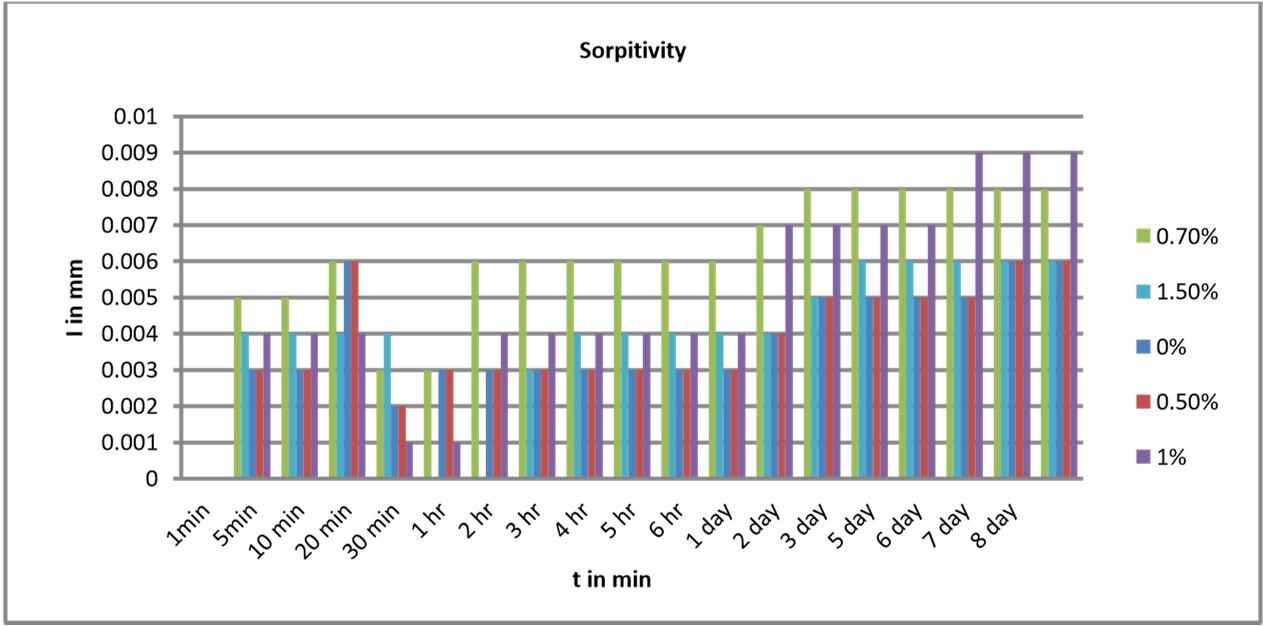
From the test results obtained 0.5 and 0.7% of basalt fiber have less water aborption and the results are similar.

The water absoption results for the HPC concrete with basalt fibers are shown below. According to the ASTM C1585 13 the results are compared.
Table 12. Test results of water absorption with various % of basalt fibers Samples W1 W2 % of water absorbed
Conventional concrete (0% basalt) 2.38 2.25 5.70%
0.5 % BFC 2.38 2.27 4.84%
0.7 % BFC 2.42 2.31 4.76%
1.0 % BFC 2.3 2.18 5.50% 1.5 % BFC 2.38 2.25 5.70%
Graph 6. Represents the test results of water absorption with various % of basalt fibers
Water Absorption
Conventional concrete (0% basalt)
From the test results we conclude that 0.7% of basalt fiber has less water absoption compared to other specimens and 4.76% is under extremely good concrete as per the ASTM Code.
ISSN: 2321 9653; IC Value: 45.98; SJ Impact Factor: 7.538 Volume 10 Issue XI Nov 2022 Available at www.ijraset.com

A scanning electron microscope is a type of microscope which provides magnified detail image of an object by scanning with the help of focused beam of electrons. The produced image can show information on sample topography and surface composition. The microstructure and topography of the HPC are as described in the following Figures for different percentage of basalt fibers.
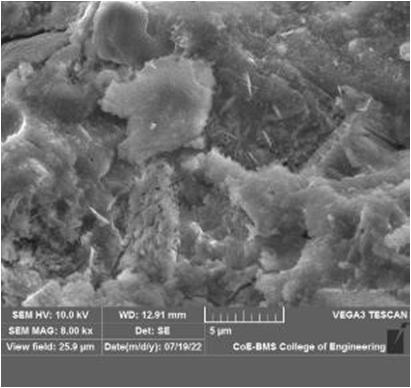
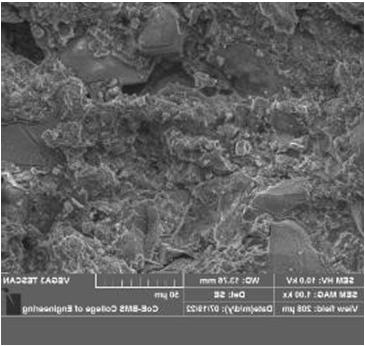
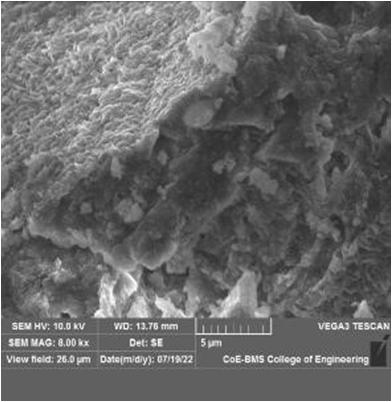
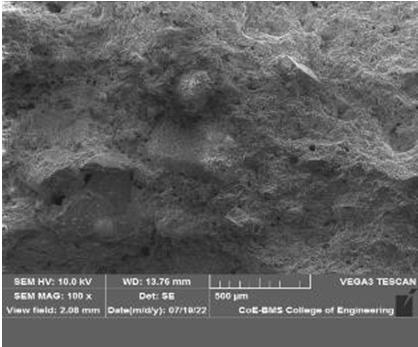
• Calcium Silicate Hydrate (C S H) gel is present, which aids in cement hydration.
• There is a huge amount unreacted calcium hydroxide (CH) flakes are present.
• In 100% concrete agglomeration is clearly visible.
• There is presence of small voids, thus results in dense packing. Crystall structures are visible.

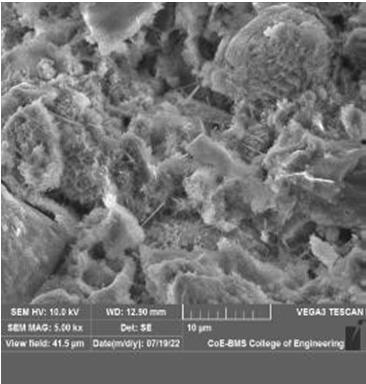
• Ettrignite (needle shaped) are formed which results in slow the setting period to obtain large amount of strength.
• In 5µm, there is a large amount of ettrignite needle (crystalline like needes) are vissible compared to 100% of cement.
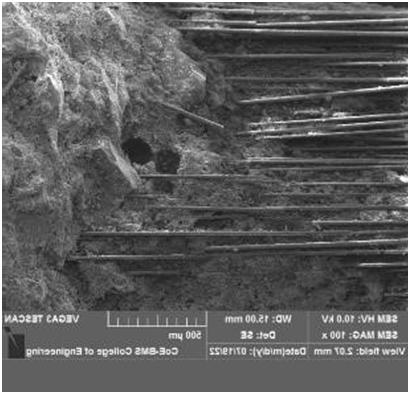
• Ettrignite means calcium sulpho alluminate hydrate
• In 20µm, cracks are vissible.
• Calcium hydroxide flakes like structure are present which rest on the C S H cluster.
• Some parts are showing smooth texture.
• Grains which are visible are some are round in shape and some are irregular in shape.
• There formation of flakes and voids presence in the 500 µm.
• The pulverised (powder) particles are clearly observed.
• In 5µm it shows a smooth surface texture.
ISSN: 2321 9653; IC Value: 45.98; SJ Impact Factor: 7.538

Volume 10 Issue XI Nov 2022 Available at www.ijraset.com
• In 20 µm it shows a formation of rough texture.
• The unreacted particles are present, the presence of unreacted particles reduces the strength of the concrete mix as well as C S H gel.
• The capillary voids are less visible because of increasing in the age of hydration are observed in the above SEM images.
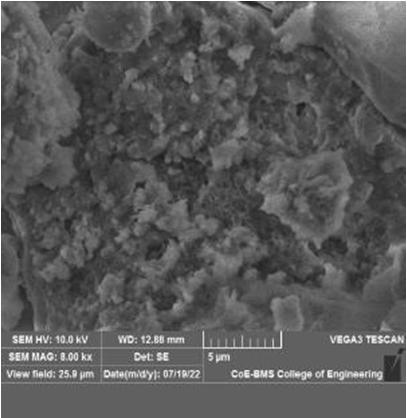
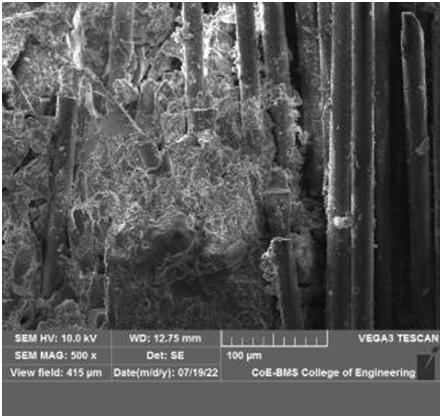
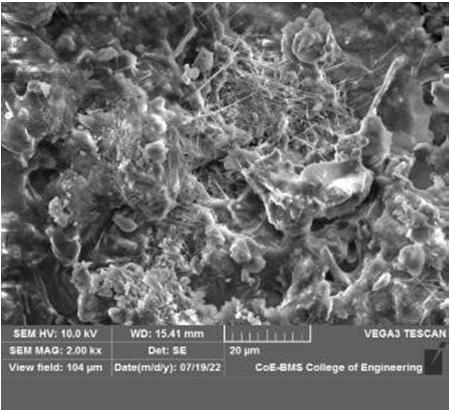

• The unreacted particles are present, the presence of unreacted particles reduces the strength of the concrete mix as well as C S H gel.
• In 100 µm it shows there is presence of flakes.
The composition of HPC concrete are as described and their compositions are tabulated for different percentage of basalt fibre.
Table 13. Composition of materials for conventional concrete 28days curing
Element Weight % Atomic %
C O2 32.47 40.63
Na 2º 1.57 1.39

Mg O 2.25 3.07
Al 2O3 8.38 4.52
Si O2 32.34 29.64
S O3 1.80 1.24
K 2º 1.15 0.67
Ca O 18.69 18.35
Fe 2O3 1.35 0.47
ISSN: 2321 9653; IC Value: 45.98; SJ Impact Factor: 7.538

Volume 10 Issue XI Nov 2022 Available at www.ijraset.com
Fig 6. EDS for Conventional concerte
Table 14. Composition of materials for 0.5% BFC after 28 days curing
Element Weight % Atomic %
CO2 22.99 30.27
Na2O 2.20 2.06
MgO 1.88 2.71 Al2O3 9.52 5.41 SiO2 30.89 29.79 SO3 0.57 0.41 K2O 0.98 0.60 CaO 26.13 27.00 Fe2O3 4.84 1.76
Fig 7. EDS for 0.5% BFC after 28 days curing
Table 15. Composition of materials for 0.7% BFC after 28 days curing



Element Weight % Atomic %
CO2 34.50 43.46
Na2O 0.67 0.60
MgO 1.39 1.91
Al2O3 6.71 3.65
Si O2 38.88 35.88 S O3 0.48 0.33 K2O 1.38 0.81
CaO 12.17 12.04 Fe2O3 3.80 1.32
ISSN: 2321 9653; IC Value: 45.98; SJ Impact Factor: 7.538

Volume 10 Issue XI Nov 2022 Available at www.ijraset.com
Fig 8. EDS for 0.7% of basalt fiber after 28 days curing
Table 16. Composition of materials for 1% BFC after 28 days curing
Element Weight % Atomic %
C O2 39.72 48.70
Na 2O 1.50 1.31 Mg O 2.31 3.09 Al 2O3 9.11 4.82 Si O2 25.16 22.60 S O3 0.66 0.44 K 2O 0.65 0.37 Ca O 18.60 17.89 Fe 2O3 2.29 0.77
Fig 9. EDS for 1% of basalt fiber after 28 days

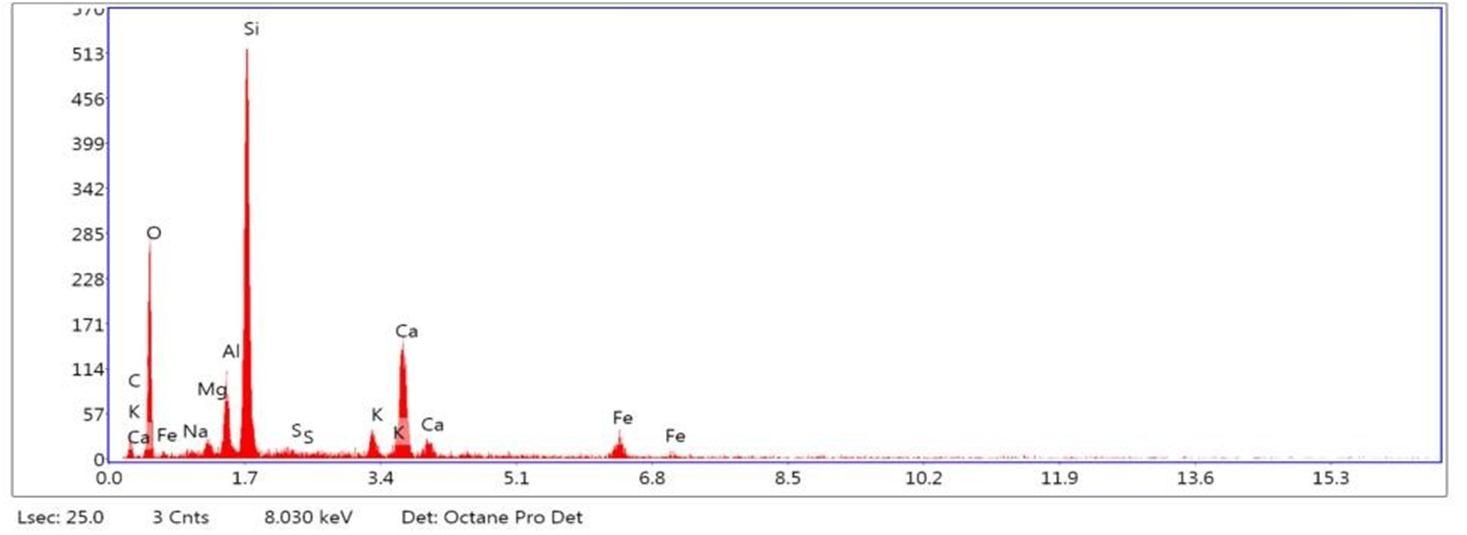
Table 17. Composition of materials for 1.5 % BFC after 28 days curing

Element Weight % Atomic %
C O2 40.98 50.17
Na 2O 1.72 1.50 Mg O 2.04 2.72 Al 2O3 7.52 3.98 Si O2 25.79 23.12 S O3 0.72 0.48 K 2O 0.72 0.41 Ca O 17.15 16.48 Fe 2O3 3.36 1.13
ISSN: 2321 9653; IC Value: 45.98; SJ Impact Factor: 7.538 Volume 10 Issue XI Nov 2022 Available at www.ijraset.com


Fig 10. EDS for 1.5% of basalt fiber after 28 days

Result Evaluation: In EDS as shown in the figure it is observed that in all the combinations Si content is more. By comparing all the images 0.5% of basalt fibers is having more percent of Si content i.e, 43.13%.


The crystallography of HPC is as described in the following for different percentage of basalt fiber.
1) XRD for conventional concrete after 28 days
Fig 11. XRD for conventional concrete after 28 days
• The graph represent 100% peak at 26.72 degree which was found to be Quartz low (o2Si1) chemical name is silicon dioxide.
• The least peak was found to be at 64.11degree that is Biotite.
• Biotite consist of potassium, iron, magnesium, aluminum, silicates etc.
• One of the most abundant compound present in control mix concrete which is represented in the above graph is Quartz.
• It represent crystalline peak means containing sharp peak.
• From XRD graph, following compounds are identified are Silicon Dioxide Quartz and Omphacite

ISSN: 2321 9653; IC Value: 45.98; SJ Impact Factor: 7.538 Volume 10 Issue XI Nov 2022 Available at www.ijraset.com

Fig 12. XRD for 0.5% of basalt fiber after 28 days
• The most abundant compound is Quartz low (O2Si1) which is at 100% peak at 27.53 degree

• The second most frequent compound is obliclase molecular formula is Al 1.16.
• Tricalcium silicate is present due to agglomaration of cement in a concrete mix.
• The compounds present in the mix are quartz low and obligoclase.
Fig 13. XRD for 0.7% of basalt fiber after 28 days


• This graph representing crystalline in nature that means producing the sharp peak.


• The highest peak produced at 26.6 degree which is Quartz low.
• The next abudant compound is Albite.
• Albite consist of calcium, magnesium, and potassium.
• Albite belongs to the group of feldspar family with the formula NaAlSi3O8
ISSN: 2321 9653; IC Value: 45.98; SJ Impact Factor: 7.538 Volume 10 Issue XI Nov 2022 Available at www.ijraset.com

Fig 14. XRD for 1 % of basalt fiber after 28 days
• The graph shows amorphorous in nature, which leads to a curve peak.
• The compounds gound are graphite 2H, Coesite and Albite.

• Graphite is highest peak obtained with 26.5 degree.
• Coesite shows the presence of crystal form of silica.
Fig 15. XRD for 1.5 % of basalt fiber after 28 days

• The presence of anorthite shows the calcium content in the material.
• Along with the anorthite also there is a presence of Quartz.
• Quartz shows the high intensity.
• This graph shows the amorphorous in nature. Amorphorous show there is a presence of powder like particles. The intensity ranges from 200 1000

When compared with the test results of compressive strength and split tensile strength addition 0.7% of basalt fibers to concrete gives adequate strength when compared to normal concrete and also other percentage replacement of basalt fibers. The maximum flexural strength is obtained for 1% of basalt fiber replacement as the addition of fibers with maximum dosage gives good flexure. From the test data we conclude that the depth of water penetration is 13 mm for 0.7 % of basalt fiber in HPC, which is durable when compared to the other samples. The penetration of the chloride ions into the concrete are based on the charge passed columbs, From the test data 0.7% of basalt fiber has low penetration which means that the usage of 0.7% of basalt fiber in HPC concrete is durable. From the test results we conclude that 0.7% of basalt fiber has less water absoption compared to other specimens and 4.76% is under extremely good concrete. Based on the result, the optimum reading was recorded at 0.7% basalt fiber concrete mix. The microstructure of the HPC made with GGBS, silica fume and basalt fiber were analysed by SEM technology for various percentage of 0.5 %, 0.7%,1% and 1.5%. X Ray Diffraction is used to figure out how crystalline materials are structured.
ISSN: 2321 9653; IC Value: 45.98; SJ Impact Factor: 7.538 Volume 10 Issue XI Nov 2022 Available at www.ijraset.com

The author would like to express the sincere thanks to our project guide Mr. Rachith K, Department of Civil Engineering, Nagarjuna College of Engineering & Technology, Bengaluru and also thankful to the assistance of personnel in the Nagarjuna College of Engineering & Technology, Bengaluru, Karnataka, India.
[1] Yong Zheng, Xiande Bao, Zhigang Peng, Qian Feng, Zhen He (2021) “Improving strength and toughness of oil well cement with modified basalt fiber” . Arabian Journal for Science and Engineering
[2] Min Li , Zhishen Wu, Fei Gong (2020). “Study on mechanical properties of alkali resistant basalt fiber reinforced concrete”. Construction and Building Materials 245 (2020) 118424.
[3] Jiang Song, Wan Yang, Gao Li Jun, Ouyang Jun Jie, Zeng Jian Yang, Wei Dong Liu (2019). “Compressive behavior of heat damaged square concrete prisms confined with basalt fiber reinforced polymer jackets”. Engineering Structures 242 (2021) 112504.
[4] Saurabh Khandelwal, Kyong Yop Rhee. (2019) “Recent advances in basalt fiber reinforced composites: Tailoring the fiber matrix interface”. Composites Part B 192 (2020) 108011.

[5] Wael Alnahhal , Omar Aljidda (2018) “Flexural behavior of basalt fiber reinforced concrete beams with recycled concrete coarse aggregates”, Construction and Building Materials 169 (2018) 165 178.
[6] Weimin Li , Jinyu Xu (2018) “Mechanical properties of basalt fiber reinforced geopolymeric concrete under impact loading”, Materials Science and Engineering A 505 (2009) 178 186.
[7] Eva Vejmelková, Dana Konˇáková, Lenka Scheinherrová, Magdaléna Dolez elová, Martin Keppert, Robert Cerny´ (2018) “High temperature durability of fiber reinforced high alumina cement composites, 6, 263 273.
[8] Jongsung Sim, Cheolwoo Park*, Do Young Moon (2017) “Characteristics of basalt fibre as a strengthening material,for concrete structures, Composites: Part B 36 (2005) 504 512.
[9] Seong ock Lee, Seung Ho Choi, Soo Han Kwon and Soo jin Park (2014) “Modification of Surface Functionality of Multi Walled Carbon Nanotubes on Fracture Toughness of Basalt Fiber Rienforced Composities.
[10] Bo Xiao, Hui Li & Guijun Xian (2011) “Hygrothermal Ageing of Basalt Fiber Reinforced Epoxy Composites: A Review”, CICE 2010 The 5th International Conference on FRP Composites in Civil Engineering.
